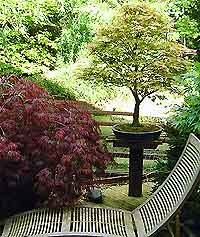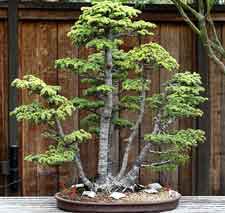Bonsai Trees
Top Tips

- Main branches should be welcoming, as you might greet with your arms. They should not be going away
- Top / apex should lean slightly forward for most styles to give depth and perspective. This does not apply to formal uprights
- Ends of branches should not point up or downwards, but be level with the soil to create stability
- At some time in most trees' lives, every single twig will need to be wired and carefully positioned. This will pay dividends as the tree matures in future years
- Always anchor wire securely, wire properly and neatly to ensure maximum bending strength
- Wire with more than one piece of wire if extra strength is needed
- Be watchful that wire doesn't bite in badly. Minor wire marks can sometimes add interest and show that the tree has been trained, giving branches character after several years. However, major wire marks are very, very ugly!

- A good base and surface roots often dictate the front of the tree, together with the main branches
- A well developed root system and healthy tree are vital in the development of bonsai
- Shorten tall trees and increase taper by reducing height discreetly, replacing the leader with a suitable side branch
- Define and groom foliage masses by removing any downward growth, leaves or needles
- Grow potential bonsai in the open ground for a few years if rapid thickening of the trunk is required
- Don't train too many trees, otherwise the ones that deserve the most attention will not get enough
- If a branch snaps but does not break in half, do not despair. Secure the break back together and seal the wound. Thin foliage being supported beyond this break to reduce the demand on branch
- Work towards triangular outlines for most styles, with larger branches lower down
- The top of almost all bonsai is the most vigourous area and so should be pruned harder. Exceptions to this are Azalea and Kiyohime maple
- Regularly thin the apex, so that branches in this area of the tree do not become too heavy and thick, spoiling the appearance
- In most styles, positioning the apex of the tree directly over the base makes the bonsai appear well balanced
- When styling, regularly refer to the front of the tree to avoid making any hasty pruning decisions
- Strategically place foliage at intervals in front of the trunk, so that the trunk line is not completely visible. This provides more interest and mystery!
- Do not be in to much of a hurry. Be patient and don't wish the years away!

